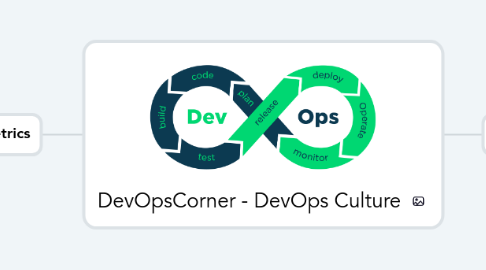
1. Indicator Metrics
1.1. Continuous Integration (CI)
1.1.1. Validity (Checker)
1.1.2. Enable Scaling
1.1.2.1. Team Size
1.1.2.2. Code Base
1.1.2.3. Infrastructure
1.1.3. Pattern
1.1.3.1. Driven Development
1.1.3.1.1. Test (TDD)
1.1.3.1.2. Behaviour (BDD)
1.1.3.1.3. Domain (DDD)
1.2. Continuous Delivery (CDe)
1.2.1. Artefact
1.2.1.1. Generate Artefact
1.2.1.2. Packaging Artefact
1.2.1.3. Immutability Artefact
1.3. Continuous Deployment (CD)
1.3.1. Scope
1.3.1.1. Scale of Size
1.3.1.2. Frequently Deployment
1.3.1.3. Time Deployment
1.3.1.4. Resources Consumption
1.3.2. Dynamic Architecture
1.3.2.1. Type
1.3.2.1.1. Cloud
1.3.2.1.2. Baremetal
1.3.2.1.3. Hybrid
1.3.2.2. Resources
1.3.2.2.1. Isolated (Container)
1.3.2.2.2. Non Isolated
1.3.3. Tools
1.3.3.1. Infrastructure As Code (Iac)
1.3.3.2. Non Infrastructure As Code (Non Iac)
1.4. Continuous Testing (CT)
1.4.1. Automation Test
1.4.1.1. Functional Test
1.4.1.2. Behaviour Test
1.4.2. Load Test (Stress Test)
1.5. Continuous Monitoring (CM)
1.5.1. Metrics (Agregatable)
1.5.1.1. Common Metrics
1.5.1.2. Custom Metrics
1.5.1.3. Anomaly's Metrics
1.5.1.4. Forecasting Metrics
1.5.2. Tracing (Request Scoped)
1.5.2.1. Serverless
1.5.2.2. Microservices
1.5.3. Logging (Event)
1.5.3.1. Stream
1.5.3.2. File R/W
1.5.4. Alerting
1.5.4.1. Trigger
1.5.4.1.1. Resources
1.5.4.1.2. Network
1.5.4.1.3. Application
1.5.4.2. Escalation
1.5.4.2.1. Priority
1.5.4.2.2. Schedule
1.5.4.3. Notification
1.5.4.3.1. SMS
1.5.4.3.2. Phone Call
1.5.4.3.3. Email
1.5.4.3.4. Webhook
1.6. Continuous Security (CS)
1.6.1. Scope
1.6.1.1. Prevent
1.6.1.2. Detect
1.6.1.3. Response
1.6.1.4. Predict
1.6.2. Improvement
1.6.2.1. Architecture
1.6.2.1.1. Isolated (Container)
1.6.2.1.2. Non Isolated
1.6.2.2. Network
1.6.2.2.1. Private
1.6.2.2.2. Public
1.6.2.3. Application
1.6.2.3.1. Single Sign On (SSO)
1.6.2.3.2. Role Base Access Control (RBAC)
1.6.2.3.3. Session
1.6.2.3.4. Credential Encryption
1.6.2.3.5. Secret Configuration
1.6.2.3.6. Storage
1.6.3. Ownership
1.6.3.1. Static Address
1.6.3.2. Application/Microservices
1.6.3.3. Object Storage
1.6.3.3.1. File
1.6.3.3.2. Folder
1.7. Continuous Chaos (CC)
1.7.1. Disaster Recovery
1.7.1.1. Schedule / Incremental
1.7.1.1.1. Backup
1.7.1.1.2. Restore
1.7.1.1.3. Clone
1.7.2. Fail Over Scenario
1.7.2.1. High Availability (HA)
1.7.2.1.1. Network Connection
1.7.2.1.2. Region / Zone
1.7.2.2. Reduce Single Point of Failure (SPOT)
1.7.3. Firedrill Scenario
2. Agile vs Waterfall
2.1. Tools
2.1.1. Scrum
2.1.2. Kanban
2.1.3. Scrumban (Scrum + Kanban)
2.2. Culture
2.2.1. Daily Standup
2.2.2. 1-on-1
2.2.2.1. @ 2 weeks / month
2.2.2.2. at least @ month
2.2.3. Retrospective
2.2.4. 360 Degree Performance Review
2.2.5. Weekly Meetup
2.2.6. Motivation
2.2.6.1. Eliminate Blamming
2.2.6.2. Fail Fast Learn Faster
2.2.6.3. Dare to Take a Risk
2.2.7. Improvement
2.2.7.1. Sharing Session
2.2.7.1.1. Public Seminar (Meetup)
2.2.7.1.2. Internal Seminar
2.2.7.2. Pair Programming
2.2.7.3. Code Review
2.3. Performances
2.3.1. OKR (Objective Key Results)
2.3.1.1. Personal
2.3.1.2. Team
2.3.1.3. Global Company
2.3.2. Service Level
2.3.2.1. SLA (Service Level Agreement)
2.3.2.2. SLO (Service Level Objective)
